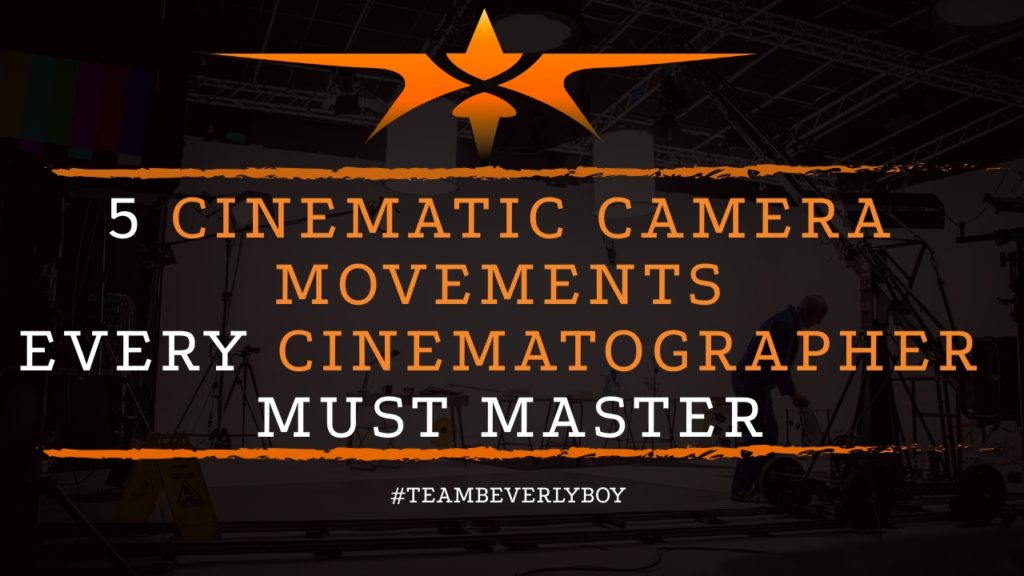Top 5 Cinematic Camera Movements Every Cinematographer Must Master
When you first begin cinematography it’s everything you can just to keep the camera steady and capture the desired shot. But then your skills grow, and you begin using cinematic camera movements to produce powerful and dramatic shots that come to life. As your skills progress, so too does your ability to use your camera to tell the story. These are the top 5 cinematic camera movements that should be mastered by the avid cinematographer so that a film can literally come alive with the camera.

1. PUSH IN SHOT
The push in shot involves moving the camera ever closer to a subject so that you can capture the full view, up close. This camera movement implies the notion that the subject on film is of great importance. We see the push in shot used in cinema quite frequently.
As the camera moves closer to the subject, definition and advanced understanding of the character is created. The subject may be speaking as the camera slowly moves in. The effect is that we feel we should listen to what the character is saying and focus intently on the individual.
To push in, the camera is placed on a slider or dolly so that it can be moved seamlessly toward the subject. Camera stabilizers can sometimes be used to create the push in camera movement but this practice is more advanced and difficult to achieve.
2. PULL AWAY SHOT

The pull away shot is essentially the opposite of the push in shot. This cinematic camera movement involves pulling the camera away from the subject so that there is a sense of loneliness or emptiness between the character and the audience.
The pull away shot is accomplished by using a dolly or slider to move the camera away from the subject. In cinema, the pull away shot is sometimes used to show a scene leading up to a conflict or a situation in which the character is feeling lonely so that there is an element of suspense as something is about to happen to the character that is all alone.
Pull away shots are also used to show who a subject is. For example, a movie scene may begin with the shot so close up that only the eyes or the hands of the subject are seen. The audience has no idea who the subject is until the camera pulls away to reveal the subject. This is an intense way to reveal a character on screen.
3. TILT-UP SHOT
The tilt-up shot is a cinematic camera movement that essentially faces the camera upwards. Regardless of where the camera starting point lies, the tilt-up shot will face the camera upwards without actually moving the camera.
In cinematic productions, the tilt-up shot is often used to reveal a scene or element of a scene. For example, a tilt-up shot may be used to show a character and then tilt up to show the background in full and expose the location of the scene.
Tilt up shots also can be used to emphasize the size or stature of an element on film. For example a very large building or tree that is in the scene may be captured in a tilt-up if the element is an important addition to the scene.
4. PAN SHOT
The pan shot is used to bring the camera from left to right or right to left. Panning is a cinematic camera movement that involves not actually moving the position of the camera but the viewable area of the lens. Pan shots are very common in cinema and tend to be used for a wide array of uses.
Panning left to right are like the infant of a tracking shot. Before filmmakers learn how to track they pan. Panning shots can be used to showcase the location of the scene or to give the audience an understanding of what is taking place in another area of the scene, shifting the focus from one side to the other with a simple movement of the camera.
5. TRACKING SHOT
The tracking shot is similar to the pan in that it can be used to track the camera from left to right or right to left but instead of moving only the viewable area, the entire camera moves with a tracking shot. Tracking shots are used in cinema to capture fast moving vehicles, to film people walking and talking, and to catch other moving elements on a set.
The tracking shot is more advanced than the pan shot and generally the preferred cinematic camera movement when compared to other movement shots listed. However, the use of the tracking shot versus the pan shot or other camera movements will ultimately depends on your preference, the situation and the style of the film being produced.
TAKE THE BROADER PICTURE INTO CONSIDERATION
As you learn more about cinematic camera movements and the various shots that you can capture just by moving the camera a certain way your films can become more inviting and engaging. There’s a certain power that comes to a cinematographer that can use the camera to tell his or her story indefinitely.
As you plan your shots, consider the various elements that will make each camera movement useful in delivering the content of your story. Keep in mind that the best told cinematic stories are those that incorporate visual elements of production alongside the camera movement techniques that are learned as you grow in the field of cinematography.


